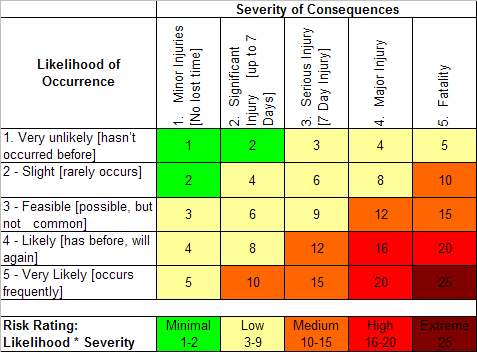|
|||||||||||||||||||||||||||||||||||||||||||||||||||||||||||||||||||||||||
| Home » Risk Rating | |||||||||||||||||||||||||||||||||||||||||||||||||||||||||||||||||||||||||
|
Risk Assessments - What is a Risk Rating?
Rating a Risk Once you have identified the hazards in your business you need to rate the risk. The rating will determine whether or not it is safe enough to continue with the work or whether you need to adopt additional Control Measures to reduce or eliminate the risk still further. You can do what is called a Qualitative Risk Rating which means you can simply decide whether the risk is minimal, low, medium or high. Generally this short hand form of risk rating is used to determine which hazard should take priority over another in terms of deciding what to do and when. To calculate a Quantative Risk Rating, begin by allocating a number to the Likelihood of the risk arising and Severity of Injury and then multiply the Likelihood by the Severity to arrive at the Rating. The number to be allocated is set out in the table below. Example: A Most Unlikely Event [1] x Trivial Injuries if event occurs [1] = Risk Rating of [1] Minimal Risk (1x1=1)
Assessed Rating Bands Minimal Risk - Rating of 1 or 2 Low Risk - Rating of 3 or 4 Medium Risk - Rating of 6 or 8 If the Rating Action Band is greater than 3 or 4 then you should review your existing Safety/Control Measures and add whatever Additional Control Measures may be necessary to bring the risk back to a Low or Minimal Risk. If you identify any hazard which, after applying any applicable control measures, is still rated as Medium, then speak to a professional health and safety advisor. High Risk - Rating of 9, 12 or 16 Alternative Risk Matrix You may wish to use an alternative Risk Matrix, perhaps one that breaks down the elements of the risk even further. One alternative would be the following:
This keys the element of severity to injuries reportable under RIDDOR. A Major Injury is one defined by the RIDDOR Regulations. Score 1-3 Minimal Risk - Maintain Existing Measures Where Frequency of Exposure is an Important Consideration the following may be appropriate:
The important thing is that you assess the level of risk and do all that is necessary to reduce it as low as reasonably practicable. Contact us to help you conduct a full risk assessment of your premises Additional Reading: What is a Risk Assessment? If this free information was useful, please recommend us or like us on our Facebook Page.
|
|||||||||||||||||||||||||||||||||||||||||||||||||||||||||||||||||||||||||

